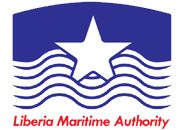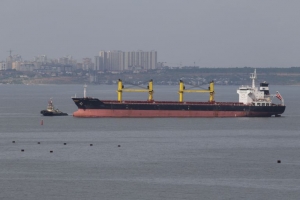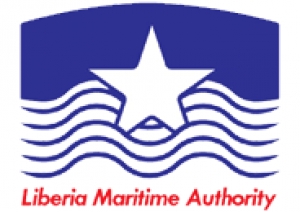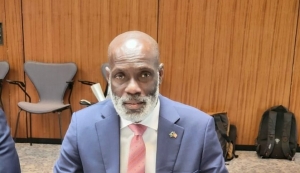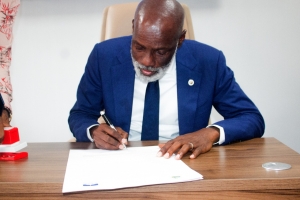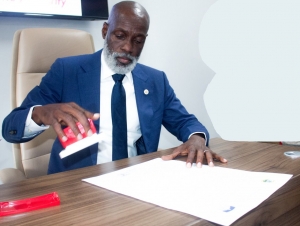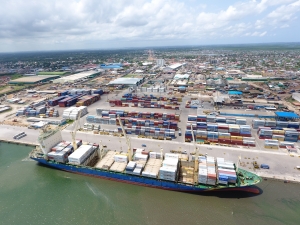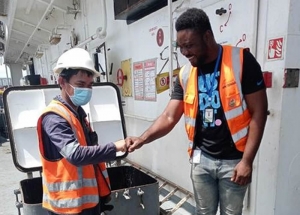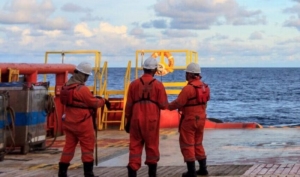Samuka Kanneh
US Coast Guard Delegation Praises Liberia's Commitment To Continual ISPS Security Compliance
December 07, 2023MONROVIA, LIBERIA – Thursday 7 December 2023): On the morning of December 7, 2023, the Liberia Maritime Authority (LiMA), as Designated Authority of Liberia’s International Port Security Program held a meeting with a delegation from the United States Coast Guard to mark the end of a weeklong ISPS assessment visit that was aimed at examining the enforcement of Anti-Terrorism Measures at Liberia’s port facilities. This was a follow-up visit. The team was here in October 2022.
The International Ship and Port Facility Security Code (ISPS Code) is a comprehensive set of measures designed to enhance the security of ships and port facilities globally. It was developed in response to the perceived threats to ships and port facilities in the wake of the September 11, 2001, attacks in the United States. It insists that all international ports formulate detailed security systems and programs at all levels of their establishments - and guarantee the provision of strict security level data to ships that fly their flags. The ISPS Code applies to seagoing vessels on international voyages, including cruise ships, tankers, and cargo ships of 500 GT and above.
In remarks, Deputy Commissioner, Charles Gono welcomed the US team on behalf of Commissioner Eugene Lenn Nage, and underscored the critical consideration that Liberia gives to the ISP measures. He expressed Liberia’s profound gratitude to the government and people of the United States for their assistance, and assured the delegation that Liberia and all its flagged ships will continue to do all it takes to comply with the requirements of the International Ship and Port Facility Security Code.
Director Simeon Cheah the head of Maritime Security at LiMA, remarked that he and his staff learned tremendously during the week of assessment. He praised the US Coast Guard for their continued support and reassured them that their suggestions would be carried out.
For his part, the leader of the American Team, LCDR Janson S. Haynes, thanked the Liberia Maritime Authority for their assessment process. He congratulated Liberia for the superb work being done – and added that apart from a few minor snags, the country was living up to its commitments, and has much to be proud of. He suggested that Liberia should now consider implementing cyber security systems for its ports and related facilities.
Signed: _______________________
Gola Traub
Director of Corporate Communications
US Coast Guard Delegation Praises Liberia's Commitment To Continual ISPS Security Compliance
December 07, 2023MONROVIA, LIBERIA – Thursday 7 December 2023): On the morning of December 7, 2023, the Liberia Maritime Authority (LiMA), as Designated Authority of Liberia’s International Port Security Program held a meeting with a delegation from the United States Coast Guard to mark the end of a weeklong ISPS assessment visit that was aimed at examining the enforcement of Anti-Terrorism Measures at Liberia’s port facilities. This was a follow-up visit. The team was here in October 2022.
The International Ship and Port Facility Security Code (ISPS Code) is a comprehensive set of measures designed to enhance the security of ships and port facilities globally. It was developed in response to the perceived threats to ships and port facilities in the wake of the September 11, 2001, attacks in the United States. It insists that all international ports formulate detailed security systems and programs at all levels of their establishments - and guarantee the provision of strict security level data to ships that fly their flags. The ISPS Code applies to seagoing vessels on international voyages, including cruise ships, tankers, and cargo ships of 500 GT and above.
In remarks, Deputy Commissioner, Charles Gono welcomed the US team on behalf of Commissioner Eugene Lenn Nage, and underscored the critical consideration that Liberia gives to the ISP measures. He expressed Liberia’s profound gratitude to the government and people of the United States for their assistance, and assured the delegation that Liberia and all its flagged ships will continue to do all it takes to comply with the requirements of the International Ship and Port Facility Security Code.
Director Simeon Cheah the head of Maritime Security at LiMA, remarked that he and his staff learned tremendously during the week of assessment. He praised the US Coast Guard for their continued support and reassured them that their suggestions would be carried out.
For his part, the leader of the American Team, LCDR Janson S. Haynes, thanked the Liberia Maritime Authority for their assessment process. He congratulated Liberia for the superb work being done – and added that apart from a few minor snags, the country was living up to its commitments, and has much to be proud of. He suggested that Liberia should now consider implementing cyber security systems for its ports and related facilities.
Signed: _______________________
Gola Traub
Director of Corporate Communications
LIBERIA'S STATEMENT CONCERNING LIBERIAN FLAGGED VESSEL, KMAX RULER (IMO No. 9436642)
November 14, 2023The Liberia Maritime Authority ("LİMA") has been informed by the owners of the Liberia flagged vessel, KMAX RULER, that it was struck by an anti- radar mnissile on or about November 8, 2023 near Pivdennyi Seaport in the Ukrainian city of Yuzhne near Odesa, killing a Ukrainian pilot, injuring three (3) crew members (Filipino nationals), and damaging the vessel's bridge and superstructure.
LiMA strongly condemns the attack on the KMAX RULER, and has launched an investigation into the attack on our flagged vessel. We respectfully call on the authorities of the Port of Odesa to investigate the matter pursuant to international law and applicable international conventions, agreements, and codes.
We stand together with all in the maritime sector to ensure the wellbeing, safety and security of seafarers, and remain steadfast in ensuring the safety and security of ships engaged in international trade.
LİMA's thoughts and best wishes are with the bereaved families as well as the injured seafarers and their families.
The Liberia Maritime Authority (LiMA) wishes to notify the public of two incidents it is currently handling involving vessels that encountered propulsion and safety difficulties in the jurisdictional waters of Liberia.
In the first incident, two vessels, MV St. Daniels and MV Bakau ran out of fuel, lost propulsion, became disabled and drifted to shore in Harper, Maryland County. Investigation by the LiMA established that MV Bakau was being towed by MV St Daniels, and they were enroute to Ghana for drydocking services. The two vessels are currently grounded in Harper, Maryland County and pose no immediate danger to navigation in the area.
Additionally, on 27 October 2022, a team of inspectors from the LiMA boarded and conducted a Special Inspection on board F/V ALTAMIR IV that was towed by the Liberia Coast Guard to Monrovia Port with the assistance of Sea Shephard. The Brazilian flagged fishing vessel was suspected of transporting unknown goods and not fishing.
Information provided to LiMA by the Captain states that the vessel departed Brazil on 15 August 2022 and was engaged in fishing activities around South East of Cabo Frio, Brazil. According to the Captain, the vessel encountered problem with its engine and the turbo motor gutted fire. As a result, it could not maneuver and then drifted for over a month during which it ran out of fuel, food and water before it was towed by the Liberia Coast Guard.
After reviewing the inspection report for F/V ALTAMIR IV, the Commissioner of the Liberia Maritime Authority, Honorable Lenn Eugene Nagbehas instructed that the deficiencies on the vessel be remedied to enable its safety and seaworthiness after which it will be allowed to sail in keeping with international maritime laws.
LiMA Recommits To Greener Shipping Treaty On World Maritime Day
September 29, 2022September 29 each year is celebrated globally as World Maritime Day. The day is set aside to focus attention on the importance of maritime safety, security and the sustainable management of the world’s aquatic environment. These celebrations are geared towards underscoring the important role maritime shipping plays in the world’s economic systems and development.
The day is being observed this year under the theme 'New technologies for greener shipping'. The Liberia Maritime Authority is therefore marking the occasion with the befitting ceremonies in support the theme, which accentuates the need for the maritime industry to transition to a greener, more sustainable future.
In the current climate crisis and the aftermath of the COVID-19 pandemic, LiMA sees this as an opportunity to focus the world’s attention on the importance and urgency of decarbonizing the maritime industry through smart technologies.
Undoubtedly, maritime transport is the backbone of international trade and the global economy. Over 80% of the volume of international trade in goods is carried by sea, and the percentage is even higher for most developing countries. But until recently, this vital industry has made few inroads toward decarbonization.
In 2018, the IMO adopted mandatory measures to reduce emissions of greenhouse gases from maritime shipping. This was done under the IMO’s pollution prevention treaty MARPOL Annex VI, which centers on Energy Efficiency Design Index (EEDI) for new ships, and Ship Energy Efficiency Manage Plan (SEEMP).
LiMA believes that today, in the light of new and significantly more powerful technologies, the maritime industry needs to adhere to every directive contained in MARPOL Annex VI, if the world is going to achieve net-zero emission by 2050, as spelled out in the Paris Agreement on the emissions of greenhouse gases.
That is why LiMA welcomes this new theme and the renewed emphasis on 'New technologies for greener shipping'.
It is our hope that more investments would be made in emerging climate innovations and technologies that would allow for a steep cut in all greenhouse gases emitted by seagoing vessels and drilling rigs and platforms amid the current climate crisis.
LiMA VOWS FULL COOPERATION WITH KOREAN AUTHORITIES IN RAPE ALLEGATIONS OF 2 OFFICIALS
September 23, 2022The Liberia Maritime Authority (LiMA), has received with grave concern reports of the arrest on allegations of sexual assault and rape by two staffers of LiMA in the Port City of Busan, South Korea.
The two Officials, Mr. Moses Owen Browne (Liberia’s Permanent Representative to the IMO) and Mr. Daniel Tarr (Director of the Department of Marine Environmental Protection), were in South Korea attending the International Maritime Organization (IMO) GHG SMART Practical Training and Study Visit (September 19-23, 2022) when this alleged incident occurred.
LiMA unequivocally maintains a zero tolerance stance on any and all types of sexual and gender-based offenses, and views these allegations of the conduct of its Officials as most egregious, having no place in any civilized society.
Liberia Maritime Authority will fully cooperate with the Government of the Republic of South Korea in the investigation of this incident and vows to take appropriate actions, pursuant to national and international laws.
Liberia Maritime Authority Vows Prosecution in Stowaway Incident
September 17, 2022The Liberia Maritime Authority is exerting all efforts in making sure that the captain and crew members of the Panama flagged vessel, MV Ophelia, that allegedly cast overboard more than a dozen people are apprehended and prosecuted in accordance with Liberian and international laws.
The incident is said to have involved about 12 stowaways claiming to be Nigerians who were found hidden on the ship. Two of them are reported to have died in the process.
Maritime Commissioner Lenn Eugene Nagbe has said LiMA has initiated a full investigation of the incident and ensure everyone involved is made to account.
He said the Liberia Maritime Authority (LiMA) and other agencies of the Government of Liberia, including the Liberia Immigration Service, are currently conducting a full-scale investigation.
While this is ongoing, LiMA has taken several actions in line with various national and international maritime standards.
Key among these measures are as follow:
1. Transmitted a formal communication to the Secretary General of the International Maritime Organization informing him of the incident. The communication is also soliciting the cooperation and support of the IMO in the investigative process;
2. Informed the Panamanian government through available diplomatic channels including a transmittal from Liberia IMO Permanent Representative Moses Owen Browne to his Panamanian counterpart. Being the flag state of the vessel, Panama has the responsibility to ensure the enforcement of relevant international instruments on the vessel, including the International Convention for the Facilitation of Maritime Trade. The communication is also intended to request representation from the Panamanian authorities during the investigation and the processes leading to the repatriation of the stowaways;
3. Communicated with the Ministry of Foreign Affairs of Liberia for a Note Verbale to be sent to the Embassy of the Federal Republic of Nigeria near Monrovia informing the Nigerian government officially through its Embassy of the incident. Nigeria is both the state of embarkation and the state of claimed nationality of the stowaways.
4. Communicated with other regional bodies including the Abuja MOU on Port State Control to assist in apprehending the vessel;
5. Communicated with the ship-owner and the agent to make representation and participate in discussions regarding arranging and financing the maintenance and repatriation of the stowaways.
On Monday, September 12, local fishermen off the Coast of Grand Kru in southeastern Liberia rescued the men. Preliminary investigation showed that they were stowaways aboard the Panama flagged vessel with IMO Number 9228083.
Port – the Centerpiece of the Maritime Industry
July 11, 2022Written By: Gola Traub
Introduction
COVID-19, along with Vladimir Putin’s war in Ukraine, has spotlighted the indispensable role that seaports and their accompanying logistical chains play in the global economy. It has also focused minds on the need for investments in efficient port management governance.
This article is an attempt to shed light on the characteristics of the different port management models and the challenges that port policymakers face in designing and operating more apt regulatory and operational regimes that ensure better outcomes in the context of constraint public budgets. This is particularly true in the developing world.
Global marine shipping is said to be the most efficient means of transporting large quantities of goods with the least environmental footprints in terms of fuel consumption and emitted gases and particles (CO2, SOx and NOx emissions). For example, it is reckoned that a single 1000-foot ship can move the same quantity of merchandise as 3000 trucks.
Basically, a port management model is the key driver of transportation costs and the costs of goods on supermarket shelves. The ongoing supply chain crisis has shown that Chinese ports, which are largely state-owned ports, operate round-the-clock with teams of dockworkers, abundant warehouses, terminal spaces and delivery systems. Resultantly, they are not suffering logjams and long delays, unlike their Western counterparts. Subsequently, the costs of imported goods in China have not skyrocketed.
While bottlenecks, shortages and delays are uncommon in developed countries, poor developing countries have a long history of poor infrastructure, stubborn bureaucratic red tape, slow turnaround time (the window in which a ship arrives at and departs a seaport), low throughputs and relatively high costs of imported goods. Port efficiency, vessel turnaround time in particular, dictates a country’s trade competitiveness.
Ports, the cardinal entries to the maritime transport system, facilitate the movements of goods across supply chains, connect coastlines to hinterlands, and link landlocked states to the ocean highways of the world. They do all of this through the multimodal transport systems of roads, railways, barges and watercraft.
It is reckoned that well over 90% of global commodities is transported through the mechanism of the maritime industry at the most cost-effective rates vis-à-vis other modes of transportation. Without ports, the main transport arteries for global trade, these affordable goods would not reach the consuming public. Ports present both opportunities and challenges, however.
The transformation in supply chain and logistics over the years is breathtaking. At first, a port was nothing more than a tool of the state, and the economic health of a port city was largely contingent on how fast and effective a port handled incoming and outgoing cargos. The literature on urban development indicates that port cities were often more economically developed and prosperous than cities without ports simply because of the volume of goods the concerned port handled and processed. Then, the conceptualization of ports was limited to cargo handling.
These days, nevertheless, with an-ever-increasing international trade, the core of the port business has shifted towards logistics service production, with greater emphasis placed on logistics costs, and the predictability, efficiency and reliability of supply chains. The current global supply chain problems underscore the importance of this shift. It is quite lucid now that logistical hiccups of this nature tend to compromise a country’s competitive edge.
Undoubtedly, with production and distribution hubs scattered around the world, ports have gained a vital position in the global supply chain. Self-evidently, then, port policymakers must improve their logistics performance by investing in quality port infrastructures and superstructures, if their ports are to continue contributing to the economy of the city in which they operate, as well as to the national and regional economics. Often, the level and type of investment made is a function of the management model of the concerned port.
(I use the terms harbors, ports, seaports and havens interchangeably in this paper.)
Port Versatilities
In many parts of the world, ports are the nexuses of finance, culture and commercial activities. They have been so since antiquity, and are often the catalysts and the spaces for industrial clustering – the locations where companies fiercely compete and become specialized in different types of value chains in areas such as conceptualization, design, production, marketing, customer support, warehousing and distribution.
This proclivity for commerce, enterprise and competition facilitates a seaport’s economies of scale (specialization in a particular sector) and makes it easier and advantageous to compete with other ports in its neighborhood and others further afield.
For example, the Port of Zeebrugge has become the center for roll-on/roll-off (RORO car services) in the Benelux countries (Belgium, the Netherlands and Luxemburg), while Antwerp has specialized in perishable goods. Both of these harbors are in Belgium.
Similarly, Europe’s largest port, Rotterdam, the world’s most automated port, is specialized in container shipping.
Broadly speaking, it is accepted that port efficiency is driven by port size and port specialization and that big and medium ports are more efficient than smaller ones. Port professionals also believe that when specialization is not possible, cooperation with a sister port is the best strategy. In essence, port size and port specialization are drivers of efficiency.
Given all of this, there is a never-ending pressure on port authorities to augment reforms, grow network efficiency and cultivate alliances, acquire more space, automate, maximize throughput and productivity, maximize profits for shareholders, attract larger investments, diversify sources of income and extend wharves to accommodate an ever-increasing vessel size and purchase or build more modern infrastructure and superstructures.
As a direct result of this intense pressure and believing that investments in port infrastructure have multiplier benefits for the national economy, many governments and port managers are ardent supporters of port reforms and development.
Enlarging, Improving and Maintaining Ports as Economic and Cultural Hubs
As intimated earlier, port facilities, these central transaction points, are indispensable components of the marine transport system. Their multifaceted organizations provide vital interfaces between coastal states and landlocked states and the ocean highways of the world. However, improving, maintaining and operating them swimmingly can be tasking and very expensive.
While cost is a bona fide consideration, harbor improvement, for example, in port management information system (PMIS), storage facilities, and cargo handling systems, help to reduce vessel-waiting times, port congestion and the costs of goods in the market. This is particularly evident when larger birthing facilities allow much larger ships to dock and bring in more goods.
In other words, as technology advances and bigger vessels are built-in our high pressured, fast paced world, there is a need for a state or its port management to make larger investments in the acquisition of port efficiency, if it wants to lower the costs of goods in its markets.
In bygone days, harbors were crowded with seagoing vessels bustling with dockworkers loading and unloading cargos – and waterfronts were famous for the splendid entertainment they provided to mariners and locals.
Indeed, the ports of the old days served as the economic and cultural centers of the cities in the surrounding regions in which they operated. Then, the question of how to invest in and manage local ports was as vexing, intense and difficult as it is today.
For eons, in the main, a port authority consisted of all public employees. These days, however, a port may be a public-private body (often loosely called a private-public partnership, PPP), a public entity or a fully privatized organization.
Port-management firms like DP World, P&O Ports, PSA International, APM Terminals and HPH Ports are often involved with the first and third categories.
The Major Functions of Ports
Ports have a number of key functions, which are fundamental to the pliability and the efficiency of the vessels that do business between them, besides serving as major points of entry and departure for goods and people.
Evidently, the cardinal purpose is to provide a secure location where seagoing vessels can berth, unload, and load. As might be expected, having a safe, functioning port, one that facilitates higher quality cargo handling and ultra large vessels like HMM Algeciras and the Evergreen necessitates enormous investments in deep approach channels, large quays and land-based facilities such as trains, roads and gantries.
A fast, flexible and efficient cargo handling system is an equally indispensable component of a modern, versatile port, the sort of port that handles different cargo types and sizes (bulk, containers, wheeled vehicles, general cargo and passengers) in the shortest dwell time.
There is also the very important matter of providing well-run storage facilities for both inbound and outbound cargos. In all of this, as indicated earlier, one cannot forget the need for a well-managed and well-integrated transport system (i.e., railways, road and inland waterways).
Oftentimes, shipping companies themselves (i.e., rubber, oil, gas, steel companies) carry out some port improvements. These sorts of port-using firms are inclined to invest in special terminals, wharves, distinct storage facilities, containerization and other port infrastructure for their trade.
Nevertheless, the port authorities and governments provide much of the needed investments or as pointed out earlier, they may seek investments from private port management companies like APM Terminals, DP World or P&O Ports.
Of course, the types of investment and the level of investment required are contingent on the port management model of the concerned port.
The Main Port Management Models
There are five main port management models, based entirely upon their roles as public or private concerns. They are service port, tool port, landlord port, corporatized port, and fully privatized port.
Each of the named models has different characteristics with respect to ownership of infrastructure, superstructures, operation of specialized terminals, and the rendering of port services such as towboat, logistics and cargo handling.
In sum, while service ports and tool ports exist largely to promote public interests, landlord ports aim to balance public interests and private interests (PPPs), whereas corporatized ports and fully privatized ports are mainly interested in maximizing the interests of their shareholders.
Service Ports
Under this model, the port authority offers a full ambit of services needed to run an operable and sound port system. Here, the port authority, usually government authority, owns the port and its infrastructure and the land. It maintains and operates every available asset, both fixed and mobile.
As well, all cargo handling functions are carried out by workers in the employ of the authority. I must stress that service ports are by nature, usually under a government ministry or an autonomous government agency.
There are fewer and fewer service ports around the world. The port of Nhava Sheva in India, the Port of Colombo in Sri Lanka, the Port of Dar es-Salaam in Tanzania and the port of Singapore are examples of service ports.
Landlord Ports
This model of port management suggests that the infrastructure, particularly terminals, is leased to a private operating company, while the port authority retains the ownership of the land and serves as the watchdog of the port.
This growing form of port arrangement speaks to a lease concession agreement, wherein a private company is given a long-term lease in exchange for a rent that is commensurate with the size of the port, as well as the investment required to rebuild, reform, modernize berths and wharves and expand the entire facility.
In addition, and perhaps crucially, the means of raising needed funds to run the operations under this model is a central plank of this kind of port model arrangement.
Here, the private operator is often responsible to provide state-of-the-art quay equipment in a bid to enhance operating standards, but the port authority, as pointed out, retains ownership of the land.
Good examples of landlord ports are the Free Port of Monrovia, the Port of Rotterdam, the Port of New York, and the Port of Buenos Aires.
Currently, the landlord port arrangement is the leading port model in larger and medium-sized ports. While, this model is seen in some major port cities, it is mainly found in developing and emerging economies. Indeed, this is probably the paragon of global Public-Private Partnerships (PPPs).
Public and Private Roles in Port Management
|
Ownership |
Port admin. |
Nautical mgmt. |
Port infrastr. |
Super-structure |
Cargo handling |
Pilotage |
Towage |
Mooring services |
Dredging |
|
|
Service Port |
Public |
Public |
Public |
Public |
Public |
Public |
Public |
Public |
Public |
Public |
|
Landlord Port |
Public |
Public |
Private company |
Private company |
Private company |
Private company |
Private company |
Private company |
Private company |
Private company |
|
Tool Port |
Public |
Public |
Private company |
Public |
Public |
Private company |
Private company |
Private company |
Private company |
Private company |
|
Corporatized Port |
Public |
Private company |
Private company |
Private company |
Private company |
Private company |
Private company |
Private company |
Private company |
Private company |
|
Fully Privatized Port |
Private company |
Private company |
Private company |
Private company |
Private company |
Private company |
Private company |
Private company |
Private company |
Private company |
Source: adapted and modified from The World Bank (2007) Port Reform Toolkit, Second Edition.
Tool Ports
Under this arrangement, the port authority owns, develops, and maintains the port infrastructure as well as the superstructure (i.e., storage, fixed equipment, warehouses, terminal buildings, and quay cranes).
Port authority employees working within a tool port framework usually, but not exclusively, operate all equipment owned by the port authority.
In other words, a tool port is akin to a service port, but differs only to the extent that small private companies carry out cargo operations, and handlers onboard docked vessels are allowed to load and unload their own vessels but the terminal equipment is still owned by the port authority.
To put it another way, there is fragmentation in cargo handling operations within a tool port setting. It can be said that a tool port is a transition between a service port and a landlord port.
The Port of Chittagong in Bangladesh and the Autonomous Ports (Independent ports) of France are examples of tool ports. Like under the landlord mode arrangements, the tool port authorities are the owners of the infrastructure and the superstructures.
Corporatized Ports
Here, a government owned port is given the legal status of a private company. This means that state assets are transferred into a corporation, but the government retains full ownership of the new company.
This arrangement is meant as an interim step before full privatization takes place - when the ownership of assets is turned to the private sector, where private funds are used to invest in port facilities, equipment and systems.
All of this, of course, is aimed at reducing the role of government in port activity and port ownership. There could not be a better example of how government services are transferred to the private sector than port privatization.
Fully Privatized Ports
Fully privatized ports are similar to service ports. These are fairly new arrangements found mainly in Britain and New Zealand, usually at very specialized havens like LNG and iron ore ports. Many pundits consider fully privatized ports as extreme forms of port reforms.
It connotes, they argue, that the government has washed its hands off the port sector and has literally “sold the sector to the dogs”. In fully privatized ports, a private company owns the land. This transfer of public land to a private firm is something unheard-of in other port management models, although the public sector (the government) retains a standard regulatory oversight. For this reason, the public sector tends to goad and push strategies that are deemed to be of public interest.
I must emphasize here that these arrangements are unique to fully privatized ports, at least for now. Indeed, the total absence of government involvement in the seaport business remains limited to very specialized harbors and terminals. Nonetheless, it is becoming quite lucid that the overall role of government in the port industry is fast diminishing.
Global Port Reforms and Governance
Generally, port reform implies changing the institutional structure of the seaport industry, something that allows much greater involvement of the private sector in the management and financing of port facilities, terminals, and services, thereby, modifying the relationships between the public and private sectors.
The unprecedented increase in world trade over the last few decades has informed and shaped national governments’ policies on the economic significance of ports, and many governments around the world have seen the importance of relinquishing the direct management of their ports and putting in place reforms intended to produce better outcomes.
This mechanism is known in the port business as “devolution”. Port devolution is largely based on a World Bank Policy Recommendation issued in the late 1980s that urged developing countries to relax their highly controlled port industry by giving concessions to nongovernmental organizations with the expertise and wherewithal to modernize and manage their ports efficiently and profitably.
Given that big infrastructural investment projects are capital intensive, large, well-resourced maritime shipping companies and terminal operators are increasingly managing the world’s seaports. The current literature indicates that these companies are good at building mergers, acquisitions and strategic alliances.
For some governments, mainly in North America and Western Europe, the crux of these reforms are geared at moving from an unimodal port system to a fully integrated port system, a port system that incorporates hinterland logistics, productions and other modes of transport – for example, rails, inner coastal waterways, barges, motorways, pipelines and airports. The National Port Council of Britain, for example, was set up for this purpose.
For other governments, however, especially governments in the developing world, port reforms have been nothing more than upgrading their shipping facilities. For instance, investing in terminal operating systems, acquiring better gateway systems, gantry cranes, better international container transfer systems, canal enhancements and additional berths. The cardinal objective of all of this, in the main, is upping the competitiveness of ports and cutting public expenditures.
For a few others, privatization entailed total devolution (outright sale) of their ports. This practice was particularly common in Western Europe and parts of Central and Eastern Europe at the very end of communism - and during the introduction of market-oriented policies in the former Soviet Republics.
The relationship between ports, societies and governments has morphed significantly since the 1990s, with major questions being asked about the appropriateness of private provision of public goods and services (i.e., the outsourcing of key port functions to private firms, which may act as service providers, operators, developers or a combination of all three groupings).
It is probably right to add that the unprecedented globalization of the means of production and distribution of goods and services that occurred during the 1990s sped up the end of the dominance of public port governance. This was especially the case in developed and middle-income countries.
Very early on during this period (the 1990s and early 2000s), it became clear that outcomes tended to vary markedly depending on whether public interests were at stake or whether private interests were at stake.
Interestingly, even with this major clarification in the debate about reform, there is no “appropriate way” or “one best way” for port governance’ recommended by port reform experts. This lack of consensus as to the best governance model has given rise to differing outcomes globally.
However, despite the diverse approaches, outcomes, and each country’s context, the general trend suggests that privatization of ports is more commonplace today than it has ever been.
It is also worth noting that in spite of the rise of port privatization, the public continues to play a part in port reforms and development, even if only perceptively. This is especially the case in developing countries, where the idea of government provision of social utility remains a potent force.
African Seaport Economics and Global Supply Chains
Like a handful of sub-regions in the developing world, Sub-Saharan Africa experienced a mini-economic boom in raw commodity export in the last few decades. This economic growth ushered in robust demands for the enlargement and the modernization of port facilities within the region, including bigger storage capacities, containerization, developed rail infrastructure, good road network, and faster turnaround time to meet the multiple dictates of an ever-expanding global supply chain.
As a result, and given the all too familiar scant availability of public funding, many governments are turning to private investors and operators. Many pundits argue that privately controlled ports are managed more economically and efficiently because they are profit incentivized to eliminate wasteful spending. Besides, privately run ports do not have to contend with the bureaucratic red tape that can plague government entities.
Notwithstanding, a few governments and their port policymakers remain fixated on the idea that state-owned and stated-operated ports are better value for money. As would be expected, many such port authorities are hemmed in by low productivity caused mainly by low investments and unqualified employees.
African ports have the additional challenge of being small and incapable of mooring large-sized vessels. This means that smaller ships have to come frequently because their merchandise volumes are insufficient, making goods relatively more expensive in Africa compared with more developed regions of the world that have the capacity to accept and handle much larger vessels, even ultra-large container vessels (ULCV) like the Liberian flagged MSC Diana and the Maltese flagged, the MV Barven.
In short, profound changes, principally in technology, have occurred in the maritime mode of transport. These changes, by all accounts, have shifted the balance between capital and port labor.
Evidently, the port industry is fast becoming a capital-intensive industry, unlike in the past when it was very labor-intensive. These changes, coupled with the fierce forces of globalization (i.e., the need for larger ships, cheaper and more flexible logistics, and faster turnaround times) are the raison d’etre for private investments in port reforms these days.
These very expensive technological changes, along with the financial hardships of recent decades, have amplified the role and the necessity for private investments in the sector.
While it is true that there is no “one size fits all” solution applicable to every port, the history of the private sector in the port business makes private funding and private management of ports an attractive option. This is particularly true for any small port that wants to be more competitive and less financially dependent on its national government.
Port Reforms at the Freeport of Monrovia
The Freeport of Monrovia is the hub of commercial port amenity and the gateway to the Liberian economy, handling well over 90% of the country’s trade. It is an artificial haven with four deliberately built piers, one primary wharf (quay) and four berths (designated mooring spots).
Literature on Liberian ports indicates that as early as 1850 commodities, especially palm products were shipped from the Port of Monrovia. The available treatise on Liberia’s largest port also suggests that reforms of the port have been in flux since American soldiers landed in the country in an effort to safeguard the smooth export of rubber to the United States for war purposes.
The Freeport of Monrovia, the West African country’s largest and most important shipping facility, was completed in 1948, something that coincided with the creation of the Liberia Maritime Program.
Freeport, as it is called, is a direct outcome of a lend-lease agreement between the American and the Liberian governments that was signed in 1944. Then, the port consisted mainly of two large breakwaters (structures built along the coasts to mitigate the effects of both weather and longshore drift/current) behind which vessels loaded and unloaded.
The port facilities had a freight storage area and terminals for iron ore, rubber and petroleum products, an access road and a bridge over the St. Paul River, all of which cost a little over 20 million USD - and much of which was lent by Washington.
The American soldiers constructed these facilities, along with a proper harbor and two breakwaters and other upgrades in 1948. They controlled much of the initial operational features and the maintenance of Freeport. The agreement between the two countries called for an American corporation to manage the port during the entire period of the loan amortization.
As a result, a firm called the Monrovia Port Management Company was formed with a number of American companies, of which the Firestone Rubber Company, the Liberian Mining Company, and the Liberian Government were major stockholders.
In 1967, the National Port Authority (NPA) was created by an Act of the Liberia National Legislature. Inevitably, this led to the replacement of the Monrovia Port Management Company.
The 1967 Act was amended in 1970, with the NPA becoming a state-owned enterprise (SOE), mandated to manage, plan, acquire land and build all public ports in the country. Today, NPA manages four ports, namely: the Freeport of Monrovia, the Port of Buchanan, the Port of Greenville, and the Port of Harper. The Freeport of Monrovia is the largest under the Authority’s umbrella.
In the wake of the country’s rancorous civil war (1989-2003) that wrecked all port infrastructures and superstructures, the Government of Liberia (GOL) set up a body called the Port Reform Secretariat of Liberia in a bid to organize, guide and expedite its port reform program
APM Terminals – the Preferred Partner
In 2008, with the backing of the World Bank, the Canadian Pacific Consulting Services (CPCS), an international port reform company and the Liberian Government signed an agreement that would convert the country’s port model from a public sector service port into a landlord port.
After a two-year study period and the submission of a comprehensive Port Master Plan, the Freeport of Monrovia transitioned into a landlord port, when the Government of Liberia awarded operational controls (container handling, cargo handling, and the like) to APM Terminals in 2010.
APM Terminals is an integrated international container/terminal operating company that provides both cargo and in land services. It is headquartered in The Hague, the Netherlands. Its contract with NPA runs for twenty-five years. Evidently, this switch was spurred by the impulse to mitigate the costs of port reforms and modernization, the need to augment performance, strengthen port reputation and flexibility, enhance customer satisfaction and boost government revenues.
As to whether or not these objectives are being met and at what price remains an open question, given the fracas that regularly arises between APM Terminals and concerned stakeholders (i.e., dockworkers, regular importers, sub-committee members of the Liberian Legislature responsible for seaports). The crux of the problem seems to be the authorization given to APM Terminals by the contract to increase container tax annually as a way of accounting for the annual rate of inflation, while it (the contract) does not spell out straightforwardly when the company should implement Freeport’s modernization.
Strictly speaking, seemingly, many people have concluded, rightly or wrongly, that APM Terminals collects taxes unremittingly but does nothing to improve the port. It is even said that some members of the Liberian Legislature have accused the company of bad labor practices and of defrauding the Liberian Government of millions of dollars and of hiking tariffs unnecessarily.
Nevertheless, as if to rebuff the chain of contentions and claims, the company recently procured new container handling equipment (3 Kalmar Reach Stackers and 4 Twin Lift Spreaders). Many pundits now expect that these newly procured machines, along with the Single Window System (SWS) that was introduced a week ago by the Liberia Maritime Authority (LiMA), would go a long way to dramatically cut the turnaround time at both the Freeport of Monrovia and the Port of Buchanan.
Conclusion
Ports have always served as key transportation centers that facilitate the movement of goods and people on the global ocean highways. Without them, international maritime supply chains would not be as they are today. In the ever-changing world of technology and vessel size, port policymakers often have to rethink their policies and revamp their ports to cope, if they wish to remain or become relevant and competitive. That is why many countries, especially developing ones, readily adhered to the World Bank’s Policy Recommendations issued in the late 1980s that asked governments to relax their government-centered port management models by encouraging private investments and expertise in a bid to modernize and manage their ports more efficiently and profitably.
Gola Traub is an educator with a BA from the University of Liberia in Geography, an MA in Education from Boston University, an MA in International Maritime Policy from Greenwich University (London), and an MA in International Relations from the University of Westminster (London). He currently heads the Department of Corporate Communications at the Liberia Maritime Authority.
